Creative and corporate – Two words that don’t strike us as complimentary.
In this article, you’ll learn how to generate innovative ideas and level up your innovation game with creative ideation. The most innovative teams in the world have tried, tested, and proven the idea generation techniques discussed in this article.
Did you know?
To help teams implement Design Thinking, we offer bespoke innovation training workshops. Talk with us and find out how we can help transform the way you design your products and services.
Interested? Message us in the bottom right corner or learn more here.
The Power of Creative Ideation
What Can You Achieve With Creative Ideation?
A well-executed ideation session can be an extremely valuable tool for you and your team. It can promote creative thinking, bond your team, give everyone a sense of ownership, and bring new perspectives on challenges and problems. It can help you create a roadmap and backlog of creative ideas to propel you ahead of the competition.
Facilitating the creation of innovative ideas is an excellent opportunity for you to demonstrate your skills as a creative leader.
Who Can Take Part in the Ideation Process?
Anyone can contribute to an idea or participate in idea creation; you can ideate with large or small groups, generate ideas on your own, or for an extra layer of insight, you can even ideate and brainstorm with customers or your target audience. In fact, the more diverse the group of people, the more diverse the ideas will be.
The tools and techniques discussed in this article apply to any ideation scenario; they’re proven effective for generating ideas for products, features and services. The frameworks outlined below are extremely popular with the world’s best software development and marketing teams.
What Is Creative Ideation?
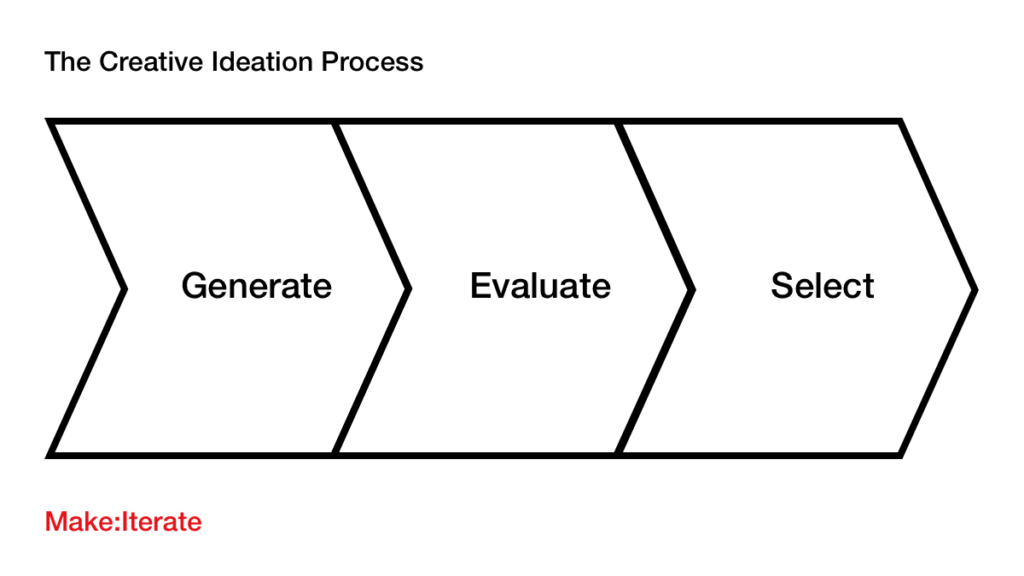
Creative ideation is the process of generating, evaluating, and selecting new ideas. We use creative techniques to unlock new perspectives and help us achieve our goal of creatively solving a problem statement or challenge.
Creative ideation usually takes place in a group or workshop setting. The outcome we’re after is to produce a collection of new ideas, ready for us to test with our customers and develop before shipping to market.
What Does Great Creative Ideation Look Like?
There’s nothing quite like a well-run creative ideation session. The atmosphere should feel light and exciting; the room should buzz with conversation and enthusiasm about new ideas.
Great ideation will leave a team feeling inspired and ready to commit to achieving their goals. Great ideation will be a memorable moment and stand out to its participants as a project highlight. Great ideation can change the direction of a team and inspire stakeholders to give their buy-in and support.
What Makes an Idea Innovative?
Valuable Innovations Solve Real Problems
Innovations solve real problems for real people – the more people who experience the problem you’re aiming to solve, and the bigger the problem is for this audience, the more significant impact your innovation will have.
Inventive ideas that don’t solve problems won’t gain traction. It’s risky to attempt to solve problems you know very little about. It’s easy to fall in love with an idea before you fully understand the problem; the consequence is that you commit your time and resources to an idea that doesn’t add value to your target audience’s lives.
Creative Solutions vs Non-Creative Solutions
Not all ideas need to be left-field, ground-breaking disruptions. Often the most straightforward idea is the best. Simple ideas are easier to execute, take less time and resources, and fall within your existing capabilities.
However, creativity thrives under the tightest of constraints. Real innovation emerges when one’s back is against the wall, and the stakes are high. Creativity is necessary for competitive industries, saturated markets, when your product is easy to replicate, or when your team is short on time or resources.
“The simplest solution, is almost always the best”
Occam’s Razor
The 4 Types of Innovation
When you’re setting out on the path to innovation, it’s helpful to understand the different types of innovation and how to leverage them within your strategy. Understanding the different kinds of innovation can help you choose a focus or a combination of methods that will give you the best chance of success.
Here are 4 types of innovation for you to consider:
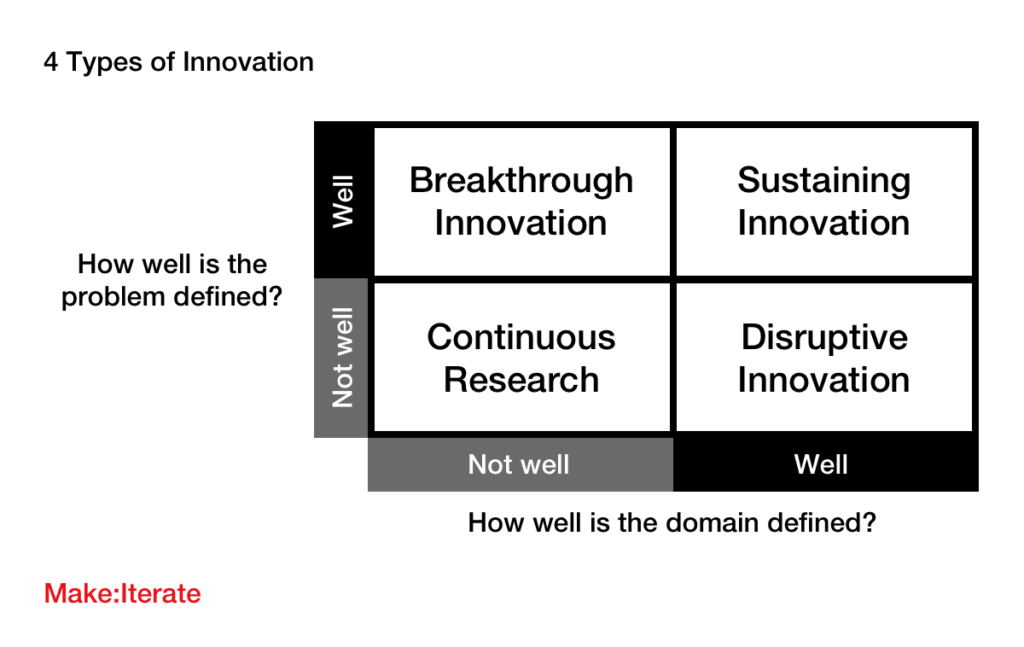
Basic Research
Basic Research is the process of continuously gathering information. Over time your knowledge bank grows, your insights deepen, and your learnings compound. Gaining this deep insight can help you iterate your product over time. Each iteration can add up to massive value. This approach is useful when the problem needs to be better defined, and you need to know your domain better and learn more about your customers and target audience.
Breakthrough Innovation
Breakthrough innovation occurs when you’ve clearly defined your problem but have yet to be able to solve it. When we combine new skills and expertise, we unlock new perspectives and achieve breakthrough innovation. Diversity of thought is a vital ingredient in the innovation process. Including experts on various subjects gives creativity a chance to connect dots you otherwise wouldn’t have been able to connect.
Sustaining Innovation
Sustaining innovation is what happens in most businesses. It’s the process of continuously improving existing products, within an established market, for a customer you’re already familiar with. It isn’t ground-breaking; you iterate and improve your product to sustain an innovation already in place.
Disruptive Innovation
Disruptive innovation is what most of us think about when we hear the word innovation. Disruptive innovation leads to the creation of new markets; it changes industries and moulds consumer behaviour. It’s when we solve problems in a way we never thought possible; it’s the holy grail often pioneered by the underdog with little to lose.
Methods of Driving Creative Innovation
We can choose from many helpful innovation frameworks to help us develop fresh ideas. These frameworks are tested, proven, and established, ready for you to apply to your work.
Notice that each framework shares similar phases: learn, ideate, and test.
These steps are critical to all design processes; each framework differs in context, values and intended audiences. Still, each can be valuable to you if your goal is to generate new inventive ideas.
It’s best to take the time to understand them, try them out, and find what works best for you. Remember, these are just frameworks; if you have special requirements, you can modify and adapt the framework to meet your needs.
Here are 5 methods for driving creative innovation:

The Creative Ideation Mindset
The creative mindset requires trust in the process and our intuition. It’s a mindset that allows thoughts to flow freely without judgement. The creative mindset is about freedom of thought, curiosity, experimentation and imagination. Creative thinking loves analogies, metaphors, and similes.
We use our unconscious to stream our thoughts, combined with lateral thinking, to come up with unusual ideas before analyzing them. This process is how we create unexpected connections and realize fresh new ideas.
An essential part of the creative process is to take breaks to allow your mind to process the information. After a certain amount of thinking, do something relaxing and unrelated to enable your thoughts to percolate. It’s often in these moments when those highly sought-after connections occur.
Human Centered Design

Human centered design is an evidence-based approach to problem solving. It prioritizes the needs of the people that we’re designing for.
Human-centered design requires understanding your user’s goals, motivations and pain points and involving them throughout the process to help us make decisions.
Getting feedback throughout the process improves your chances of getting it right. So we create opportunities to validate our thinking by getting customer feedback at different stages of the process.
Getting feedback throughout the process improves our chances of success. It helps to guide our thinking and reduces the risk of failure. So it’s often cheaper to use a human-centred design approach because our work is evidence-based and validated, which gives us confidence before we commit our resources.
Jobs to Be Done
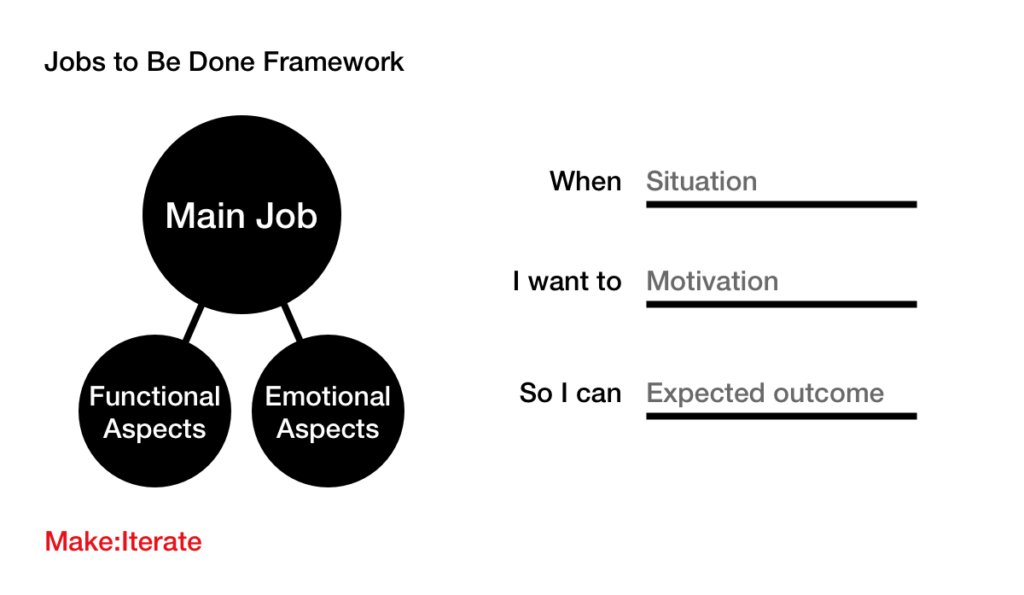
Jobs-to-be-done is a framework created by Clayton Christensen – a Harvard Business School Professor – credited with creating the theory of disruptive innovation.
The theory states that people hire products as tools to get their jobs done. The classic example is that people don’t buy a drill. They buy the hole in the wall. Although, one may even go further to say that what they purchase is a shelf hung securely.
Jobs can be emotional, functional, or social. We research to understand this need before generating ideas and validating them with customers.
Design Thinking
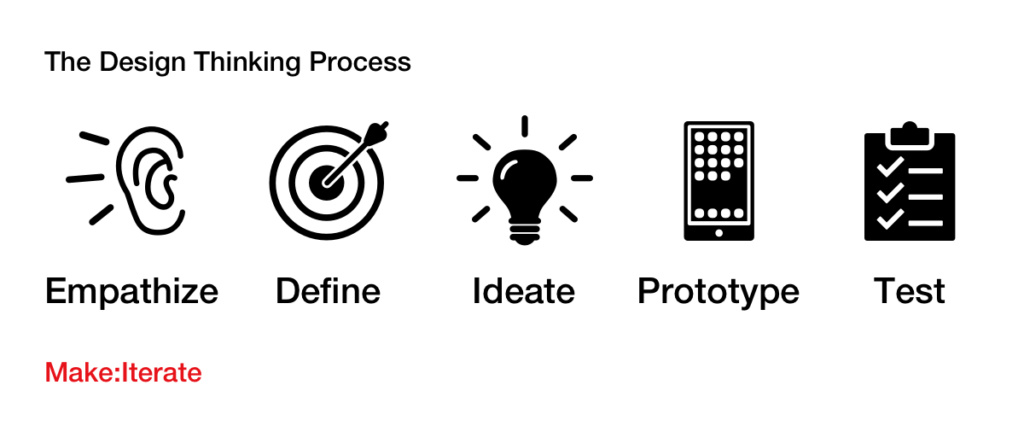
Design thinking is a human centered design approach to solving problems.
The first step is to gain empathy for our customers by speaking with them and conducting user research. We then define the problem, identify pain points, and discover opportunities by analysing the information gathered in the previous phase.
The next step is to generate, discuss and develop our ideas before finally prototyping and testing them with our customers.
Design Council’s Double Diamond

The Design Council developed the Double Diamond as an end-to-end framework for innovation.
The first step is to discover our subject and learn all we can through conducting research and gathering information. Then we define a problem and articulate a challenge. After that, we develop solutions and deliver the outcome.
The Double Diamond values people, communication, and collaboration as the key drivers of the innovation process.
Design Sprint
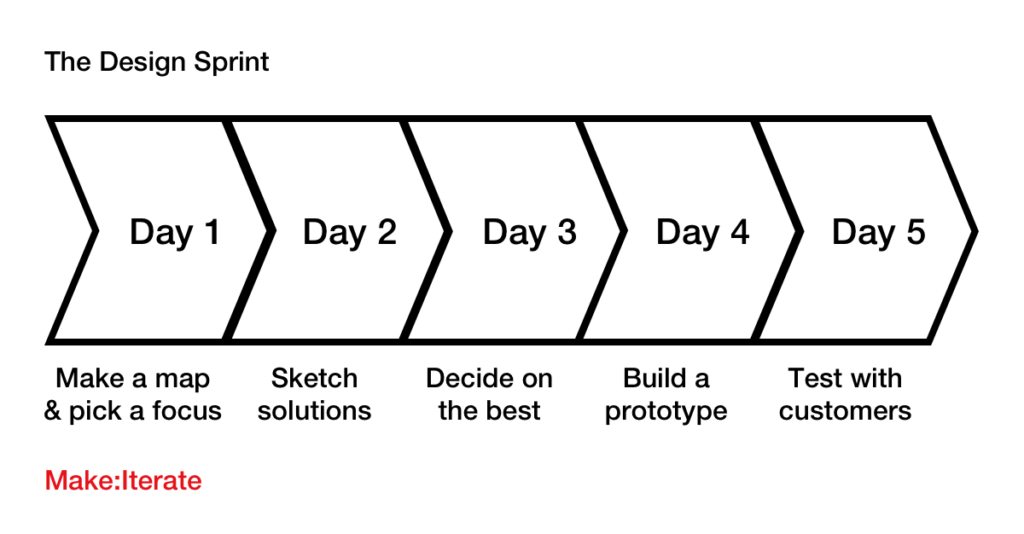
Google ventures developed the Design Sprint as a rapid idea development framework. It helps teams create new features for products and services during a 5-day process where we generate and validate our ideas.
Design Sprints are collaborative, fast-paced, and based on human-centred design principles. The first step is to map the customer experience and choose a Focus. We then generate, evaluate and discuss inventive ideas.
Finally, we choose the best ideas and build a realistic prototype. We then test this idea with customers to validate our thinking. It’s important to note that the prototype doesn’t need to be functional. It can be a sketch, a low-fidelity mockup, or even a written explanation. It’s your choice of which format is most suitable for you, depending on your time and the information you need to gather at this phase.
Creative Ideation and Brainstorming Techniques
Brainstorming and ideation are sometimes used to mean the same thing. But there are subtle differences. A brainstorming session is an idea generation technique that we use to generate a wealth of ideas.
Brainstorming can be done on the spot with little preparation. It can be an informal and spontaneous approach to problem solving.
Ideation is the process of generating, evaluating, and selecting ideas.
Ideation takes planning, prep work, time and commitment.
The brainstorming technique is used within the ideation process. We’ll talk more about the end-to-end ideation process later. For now, let’s look at some creative or idea generation techniques.
Here Are 10 Creative Idea Generation Techniques
Warning! Bravery and trust are required to get the most from these idea generation techniques. The more experimental techniques can sometimes make people uncomfortable if they’re unfamiliar with the creative process.
But these creativity techniques will make generating fresh ideas fun.
If you’re facilitating the session, it’s your job to ensure everybody feels comfortable and safe sharing their thoughts and ideas. Let everyone know that we aren’t judging their thoughts at this stage. We’re here to have fun and imagine new possibilities. Encourage everyone to trust the process and reassure them that this is a time to explore and play.
You should experiment with different techniques. Combine several, or modify them in a different way to get a different perspective and discover the best ideation technique for you.
Random Association
- Choose a challenge or a problem to solve.
- Assign each participant with a completely random word.
- Based on the random word, write down the first related word you think of.
- Now, based on the last word you wrote, think of another related word.
- Continue to write related words, in sequence, for a set amount of time.
- Now, ask everyone to choose a word from the list you just wrote.
- Think about how the random word relates to the challenge or problem.
- Now, sketch out some ideas inspired by the random connection.
Creative Matrix
- Choose a challenge or a problem to solve.
- Draw a large grid on a wall or whiteboard.
- Across the top row, list your customer segments or personas.
- Down the left column, list the journey phases or key insights.
- Brainstorm ideas within the cells based on the intersecting points.
- Talk through the ideas and vote on your favorites.
SCAMPER
- Take an existing idea, product or feature as a starting point.
- Put it on a wall or whiteboard and give everyone sticky notes.
- Look at the wall, ask questions, and capture the responses.
- Substitute: What can we substitute for something else?
- Combine: How can we combine two or more parts?
- Adapt: Which parts can we adapt or change?
- Modify: What can we modify, exaggerate or emphasize?
- Put to another use: How else could this be used?
- Eliminate: What can we remove, reduce or simplify?
- Rearrange: What can we rearrange, reorder or reverse?
- Take your reflections, discuss them, and use them to iterate the idea.
6,3,5 Brain-writing
- Choose a challenge or problem to solve.
- Gather 6 people around a table or on a video conference.
- Ask each person to take 5 minutes and brainstorm 3 ideas.
- Then pass their ideas to the next person to build upon.
- Continue passing the ideas around until you’ve completed the circle.
- Review and discuss the ideas together.
- Vote on the ones you want to take forward.
- For a similar exercise that can be done solo, see ‘mind mapping’.
Charette
- Choose a challenge or problem to solve.
- Gather several small groups of 3-4 participants.
- Each group should discuss the challenge and sketch ideas.
- The group then reviews, refines and selects the best ideas.
- Each group then passes their ideas to the next group.
- Continue passing ideas around, building on each other’s work.
- Once the circle is complete, organize, prioritize and select ideas.
Starbursting
- Choose a product, idea, theme, problem or challenge.
- Draw a 6-pointed star and write the chosen stimulus in the centre.
- On each point, write in sequence: Who? What? How? Where? When? Why?
- Brainstorm questions starting with the prompt on each point.
- For example: Who? – Who would get the most value from this product?
- Continue around the star, brainstorming questions until you’ve finished.
- Now, ask the group to vote on the most thought-provoking questions.
- Take some time to discuss and answer the questions.
- This is an excellent exercise for kicking off an ideation session or workshop.
Fishbowl
- Choose a challenge or problem to solve.
- Gather a group of people and split them into two groups.
- One group will discuss the challenge while the other group observes.
- Then switch so the other group discusses and the other group observes.
- When the time is up, get together and discuss the observations.
- Have someone write up notable ideas and thoughts on a board.
Round Robin
- Choose a challenge or problem to solve.
- Gather a group of people in a room or on a remote whiteboard.
- Each person is to spend some time generating solutions to the problem.
- Everyone then passes their idea to the person next to them.
- They then create an idea based on the idea they’ve just received.
- Continue going around the circle as many times as you like.
- Once the time is up, group the ideas into themes.
- Discuss the themes and vote on your favorite ideas.
Rapid Ideation
- Choose a challenge or problem to solve.
- Set a timer for 8 minutes.
- Ask everyone to generate 8 ideas.
- Ask everyone to share their ideas back to the room for discussion.
- Repeat the exercise multiple times, introducing different stimuli.
- For example: “Now imagine you’re Elon Musk; generate another 8 ideas.”
- “Now think about how a child would solve the problem.”
Mind Map
- Choose a challenge or problem to solve.
- Start generating ideas and writing them on a board.
- Draw a branch from each idea and write something inspired by it.
- Continue generating ideas until you’ve filled the page.
- You can do mind mapping solo or in a group.
How to Generate Innovative Ideas
Below I’ve outlined the process for generating innovative ideas. These ideas come from years of experience as a design leader practicing the design frameworks we looked at before. Start at the beginning and work your way through. After repeating the process a few times and gaining experience, you can adapt and modify it based on the projects you’re working on.
Here’s an end-to-end idea generation process for discovering innovative ideas:
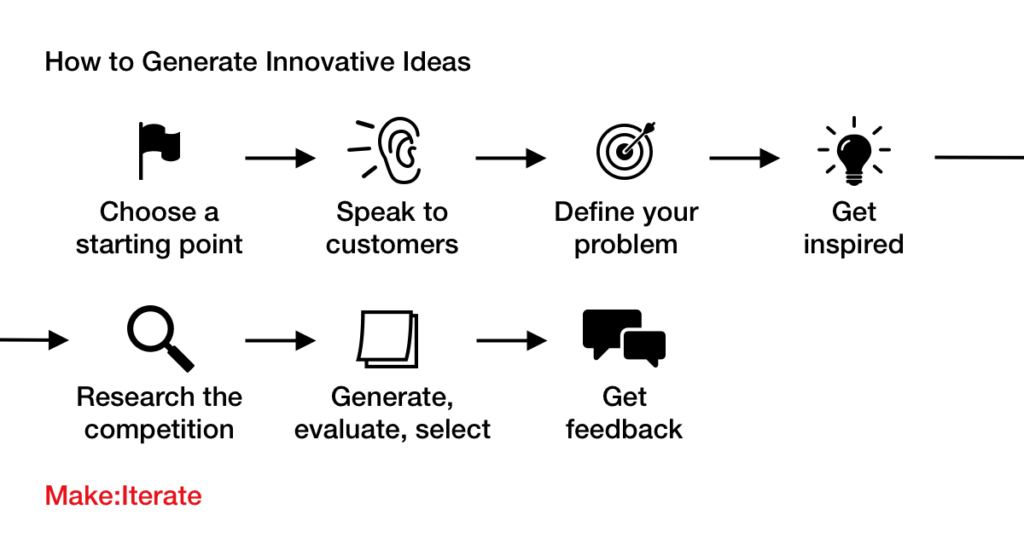
Choose a Starting Point
If you already know what problem you want to solve, you can skip this Step. If you don’t know where to start, or need a new angle, it’s common to feel frustrated or overwhelmed when choosing a starting point.
The design process is ambiguous and at times confusing. When we get started and move forward, things become clearer. After all, it’s at the beginning of a project when we know the least.
The best way to start is by speaking to your customers. Seek to understand their experiences, goals, needs, and pain points. You can also look at data and Analytics to help you identify a problem area to begin your investigation.
Or, if it’s a less formal project, you can choose an area of interest, dig deep, and find a worthy problem.
Speak to Your Customers
All effective design processes start and end with the customer. We first speak to customers to understand their experiences and goals. We talk to them along the way to get feedback and to help guide our thinking. We speak to them at the end of the project to validate our ideas and gain confidence in our direction.
This stage of the project is about building empathy and gaining insight into our target audience’s experiences, behaviors, and attitudes.
You can speak to your customers during one-on-one interviews, focus groups, and workshops, or you can send out surveys and poles together quantitative information. You can recruit customers using online recruitment tools, recruitment agencies, or your social media and owned channels.
Define Your Problem
After you’ve spoken with your customers, you’ll have a heap of data. You’ll need to organize this data and turn it into a useful format. Some artifacts that help to organize your data are personas, journey maps, and problem statements.
Having a clearly defined problem is critical to success. You’ll use it as a jumping-off point for ideation, to evaluate your ideas, and you’ll use it to create metrics to determine whether or not your innovation has been successful.
Take your time to get to know the problem. Add a layer of creativity by reframing your problem a few times. Reword it and look at it from different angles to see if you can inspire an unexpected direction.
“If I had an hour to solve a problem, I’d spend 55 minutes thinking about the problem and five minutes thinking about solutions.”
Einstein
Research the Competition
Before you generate ideas, it’s essential to know what the competition is up to. By competitors, we don’t just mean direct competitors within your industry. We mean any other product or service that aims to solve the same problem as you. For example, Netflix CEO Reed Hastings quipped that their main competitor was sleep. Spend some time reviewing the competition, compile a competitor analysis, and identify threats that they pose and opportunities they’ve left exposed.
“You get a show or a movie you’re really dying to watch, and you end up staying up late at night, so we actually compete with sleep.”
Reed Hastings – Netflix CEO
Get Inspired
Now it’s time to put your creative hat on. Creativity feeds on inspiration. It connects dots and creates pathways. Use this time to have fun and find inspiration. Don’t just look at competitors. Look at un-related fields too. You can look to art, architecture, nature and music for inspiration. The best ideas can come from drawing analogies to unrelated fields.
Generate, Evaluate, and Select Ideas
At this stage, we want to use one of the many brainstorming techniques discussed earlier in this article. Typically at the start of ideation, we aim for quantity over quality. The aim is to get all the obvious ideas onto the table. We then encourage ourselves and our teams to push beyond them.
For effective idea generation, we need to feel safe sharing our thoughts.
Encouraging people to open up is the art of facilitation.
Once we’ve generated a range of different ideas, we discuss and critique them with our teams. We want to ensure that our creative solution is solving our problem. We can do this as a written or verbal exercise. A decision-making matrix can help us select ideas. Another helpful tool for vetting ideas is the DVF framework, where we assess ideas based on their desirability, viability, and feasibility.
Get Feedback on Your Idea
Finally, we get feedback from customers. It doesn’t mean it’s the last step in the process, as it isn’t linear. It’s cyclical. Often we cycle through the phases of the ideation process to deepen our thinking. We can cycle through the same phase multiple times, repeat the process on different aspects of the ideas, or go deep in some areas and stay lean and agile in others.
At this stage, we want to validate ideas and learn from customers. We want to see them interact with the idea, share their thoughts, and observe their reactions. We then use this information to develop the ideas further.
At this point, you need to create something to share with customers. Now is where the prototype comes in. It can be a functional prototype, a sketch, or a description. It’s up to you to decide which format is necessary for your goals.
How to Plan and Facilitate an Ideation Workshop
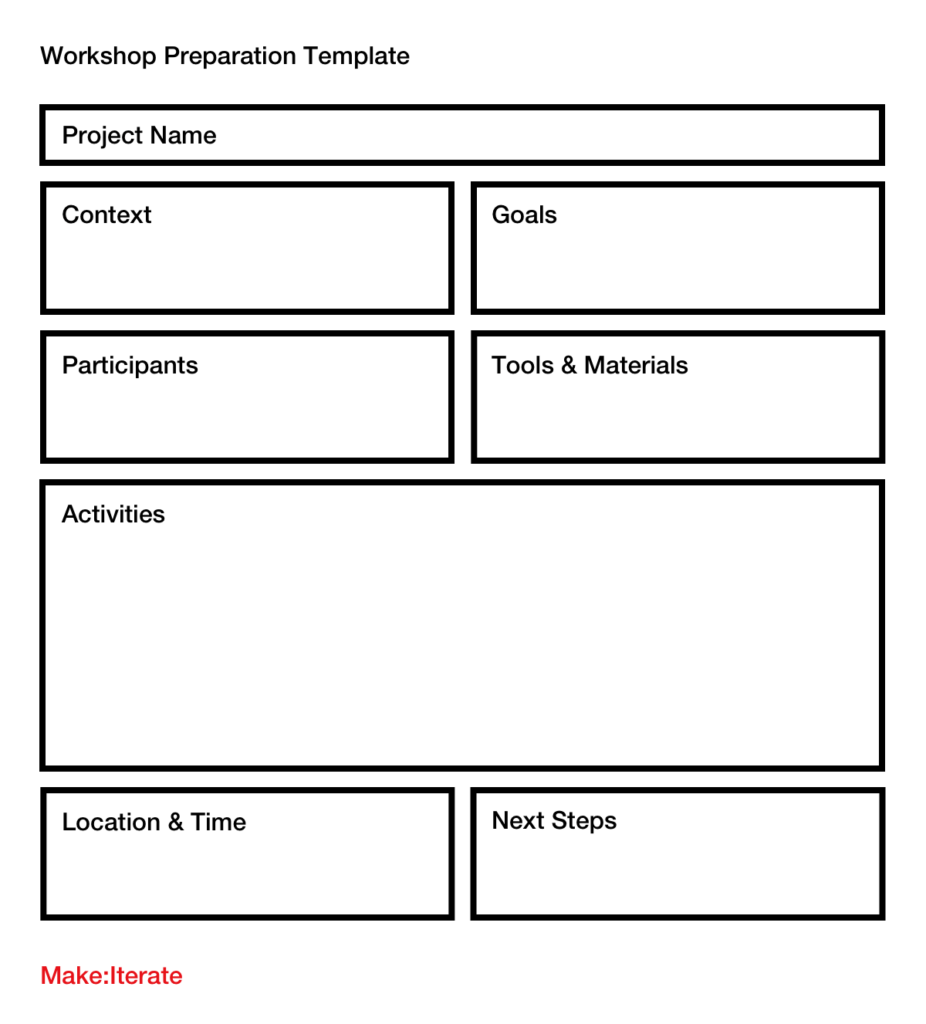
How to Plan a Creative Ideation Workshop
The quality of your ideation workshop will directly reflect the quality of your plan. To help you with the planning phase, I’ve created a canvas for you to use to help prepare for the session. You can do this independently or work through the canvas with your team or stakeholders.
You’ll need to articulate clearly the goals of ideation and the problem you’ll be solving. And you need to have an agenda and a set of activities prepared. After, you need to send out invitations and book participants.
How to Facilitate a Creative Ideation Workshop
Facilitating an ideation workshop is about creating a safe space for your participants. People need to focus on the task without overthinking the instructions.
If people aren’t familiar with or haven’t taken part in an ideation session before, it’s common for them to feel hesitant to open up and share their thoughts. It’s your job to create a safe space and ensure everybody feels included and valued.
The participants must be absolutely clear on what they’ve been asked to do. They need to enjoy the process, be relaxed, and feel comfortable. It’s your job as a facilitator to make sure that these needs are met.
How to Keep Momentum and Gain Traction
After your ideation session, you need to keep momentum to gain traction and get your innovative idea off the ground. Sharing the process and outcomes with stakeholders can encourage them to buy into your ideas and inspire them with new possibilities. Product development requires the support of the whole organization, so consider how you can provide evidence and inspire them to buy into your great idea.
Since your ideas may not be fully formed, they’ll likely need further research and development sessions. Create a plan to continue developing your ideas. Speak with project managers to prioritize your ideas and ensure they’re giving the attention they deserve. Use the participants from the session to help gain traction, turn them into advocates, and get their support to take the ideas further.
Ideation Tools and Materials
If you’re running a remote workshop, you can do everything online. All you need is a whiteboard or collaboration tool like Miro or FigJam. Both of these have free plans that you can use for your workshop. All you’ll need to do is set up your activities on the collaboration board and include the URL in the invites you send out to participants.
If you’re running a workshop in person, you need more materials. You need pens and paper for everyone to use—a blank wall or whiteboard to capture notes and pin-up ideas. And, sometimes, a projector helps share insights and context. It’s also a good idea to plan drinks, snacks, and food. Keeping everyone fed and making them comfortable is essential.
Idea Generation Checklist
Here is an idea generation checklist to remind you of the steps in the process and what you need to do along the way.
Alternatively, bookmark this article and refer to it when ready to discover your new idea.
- Choose a starting point
- Speak to customers
- Gather some insights
- Research the competition
- Get inspired
- Generate ideas
- Evaluate ideas
- Select ideas
- Get feedback from your customers


